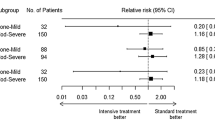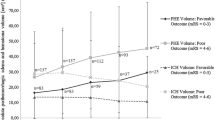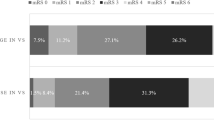Abstract
Background
We ascertained the occurrence of global cerebral edema manifesting as increased brain volume in subjects with intracerebral hemorrhage (ICH) and explored the relationship between subject characteristics and three month outcomes.
Methods
A post-hoc analysis of a multicenter prospective study that recruited patients with ICH, elevated SBP ≥170 mm Hg, and Glasgow Coma Scale (GCS) score ≥8, who presented within 6 h of symptom onset was performed. Computed tomographic (CT) scans at baseline and 24 h, submitted to a core image laboratory, were analyzed to measure total brain, hematoma, and perihematoma edema volumes from baseline and 24-h CT scans using image analysis software. The increased brain volume was determined by subtracting the hematoma and perihematomal edema volumes from the total brain volume.
Results
A total of 18 (44 %) of 41 subjects had increased brain volume that developed between initial CT scan and 24-h CT scan. The median increase in brain volume among the 18 subjects was 35 cc ranging from 0.12 to 296 cc. The median baseline GCS score was 15 in both groups of subjects who experienced increased brain volume and those who did not, and the median hematoma volume was 10.18 and 6.73, respectively. Three of the 18 subjects with increased brain volume underwent concurrent neurological deterioration and one subject died during hospitalization.
Conclusions
We found preliminary evidence of increased cerebral brain volume in subjects with good grade and small ICHs, which may be suggestive of global cerebral edema.

Similar content being viewed by others
References
Qureshi AI, Mendelow AD, Hanley DF. Intracerebral haemorrhage. Lancet. 2009;373:1632–44.
Gebel JM Jr, Jauch EC, Brott TG, et al. Natural history of perihematomal edema in patients with hyperacute spontaneous intracerebral hemorrhage. Stroke. 2002;33:2631–5.
Zazulia AR, Diringer MN, Derdeyn CP, Powers WJ. Progression of mass effect after intracerebral hemorrhage. Stroke. 1999;30:1167–73.
Mun-Bryce S, Wilkerson A, Pacheco B, et al. Depressed cortical excitability and elevated matrix metalloproteinases in remote brain regions following intracerebral hemorrhage. Brain Res. 2004;1026:227–34.
Carhuapoma JR, Barker PB, Hanley DF, Wang P, Beauchamp NJ. Human brain hemorrhage: quantification of perihematoma edema by use of diffusion-weighted MR imaging. AJNR Am J Neuroradiol. 2002;23:1322–6.
Kidwell CS, Saver JL, Mattiello J, et al. Diffusion-perfusion MR evaluation of perihematomal injury in hyperacute intracerebral hemorrhage. Neurology. 2001;57:1611–7.
Kidwell CS, Burgess R, Menon R, Warach S, Latour LL. Hyperacute injury marker (HARM) in primary hemorrhage: a distinct form of CNS barrier disruption. Neurology. 2011;77:1725–8.
Antihypertensive Treatment of Acute Cerebral Hemorrhage (ATACH) investigators. Antihypertensive treatment of acute cerebral hemorrhage. Crit Care Med. 2010;38:637–48.
Qureshi AI, Palesch YY, Martin R, et al. Effect of systolic blood pressure reduction on hematoma expansion, perihematomal edema, and 3-month outcome among patients with intracerebral hemorrhage: results from the antihypertensive treatment of acute cerebral hemorrhage study. Arch Neurol. 2010;67:570–6.
Hussein HM, Tariq NA, Palesch YY, Qureshi AI. Reliability of hematoma volume measurement at local sites in a multicenter acute intracerebral hemorrhage clinical trial. Stroke. 2013;44:237–9.
Hartman RE, Rojas H, Tang J, Zhang J. Long-term behavioral characterization of a rat model of intracerebral hemorrhage. Acta Neurochir Suppl. 2008;105:125–6.
Nys GM, van Zandvoort MJ, de Kort PL, Jansen BP, de Haan EH, Kappelle LJ. Cognitive disorders in acute stroke: prevalence and clinical determinants. Cerebrovasc Dis. 2007;23:408–16.
Su CY, Chen HM, Kwan AL, Lin YH, Guo NW. Neuropsychological impairment after hemorrhagic stroke in basal ganglia. Arch Clin Neuropsychol. 2007;22:465–74.
Su CY, Wuang YP, Chang JK, Guo NW, Kwan AL. Wisconsin card sorting test performance after putaminal hemorrhagic stroke. Kaohsiung J Med Sci. 2006;22:75–84.
Lampl Y, Shmuilovich O, Lockman J, Sadeh M, Lorberboym M. Prognostic significance of blood brain barrier permeability in acute hemorrhagic stroke. Cerebrovasc Dis. 2005;20:433–7.
Butcher KS, Baird T, MacGregor L, Desmond P, Tress B, Davis S. Perihematomal edema in primary intracerebral hemorrhage is plasma derived. Stroke. 2004;35:1879–85.
Rosenberg GA, Mun-Bryce S, Wesley M, Kornfeld M. Collagenase-induced intracerebral hemorrhage in rats. Stroke. 1990;21:801–7.
Manaenko A, Fathali N, Khatibi NH, et al. Arginine-vasopressin V1a receptor inhibition improves neurologic outcomes following an intracerebral hemorrhagic brain injury. Neurochem Int. 2011;58:542–8.
Kleindienst A, Dunbar JG, Glisson R, Marmarou A. The role of vasopressin V(1A) receptors in cytotoxic brain edema formation following brain injury. Acta Neurochir (Wien). 2013;155:151–64.
Molnar AH, Varga C, Berko A, et al. Prevention of hypoxic brain oedema by the administration of vasopressin receptor antagonist OPC-31260. Prog Brain Res. 2008;170:519–25.
Shuaib A, Xu Wang C, Yang T, Noor R. Effects of nonpeptide V(1) vasopressin receptor antagonist SR-49059 on infarction volume and recovery of function in a focal embolic stroke model. Stroke. 2002;33:3033–7.
Nakamura T, Kuroda Y, Yamashita S, et al. Edaravone attenuates brain edema and neurologic deficits in a rat model of acute intracerebral hemorrhage. Stroke. 2008;39:463–9.
Wagner KR, Xi G, Hua Y, et al. Lobar intracerebral hemorrhage model in pigs: rapid edema development in perihematomal white matter. Stroke. 1996;27:490–7.
Kempton MJ, Ettinger U, Schmechtig A, et al. Effects of acute dehydration on brain morphology in healthy humans. Hum Brain Mapp. 2009;30:291–8.
Bhalla A, Sankaralingam S, Dundas R, Swaminathan R, Wolfe CD, Rudd AG. Influence of raised plasma osmolality on clinical outcome after acute stroke. Stroke. 2000;31:2043–8.
Disclosure
Dr. Qureshi has received funding from the National Institutes of Health RO1-NS44976-01A2 (medication provided by ESP Parma), American Heart Association Established Investigator Award 0840053N, National Institute of Health U01-NS062091-01A2, and the Minnesota Medical Foundation, Minneapolis, MN.
Author information
Authors and Affiliations
Consortia
Corresponding author
Rights and permissions
About this article
Cite this article
Qureshi, A.I., Majidi, S., Gilani, W.I. et al. Increased Brain Volume Among Good Grade Patients with Intracerebral Hemorrhage. Results from the Antihypertensive Treatment of Acute Cerebral Hemorrhage (ATACH) Study. Neurocrit Care 20, 470–475 (2014). https://doi.org/10.1007/s12028-013-9842-1
Published:
Issue Date:
DOI: https://doi.org/10.1007/s12028-013-9842-1




